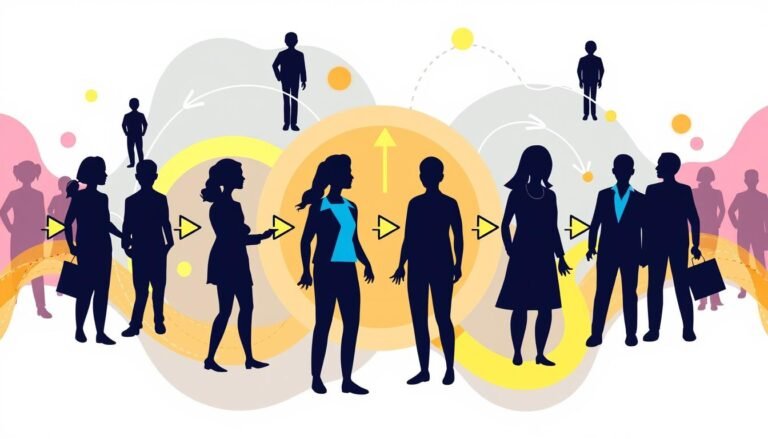Measuring and Improving Employee Engagement in Irish Workplaces
Walking through Dublin, you feel the city’s vibrancy. I also sensed this energy in workplaces around Ireland where people work together, innovate, and commit. The key to standout companies is their employee engagement strategies. A happy, productive team isn’t luck. It’s the result of careful planning and ongoing action.
Gallup’s 2020 study looked at 276 organizations worldwide, surveying 2.7 million employees. Teams highly engaged saw big benefits. Absenteeism fell by 81%, workplace injuries decreased by 64%, and profits rose by 23%. For Ireland, these findings highlight the path to boost productivity and team happiness through engagement.
The study’s major findings point to a clear fact. Having an engaged team isn’t just nice; it’s a must for success. The benefits stretch from lower turnover rates to higher productivity. Engaged employees not only perform better but also solidify a company’s brand.
In Ireland, we blend global knowledge with local ways to create a supportive work environment. Here, everybody is encouraged to offer their best. By focusing on employee engagement strategies, Irish companies can keep their lead and nurture a committed staff.
Key Takeaways
- Gallup’s meta-analysis reveals significant business outcome improvements with high employee engagement.
- Key statistics include 81% reduction in absenteeism and 23% increase in profitability.
- Engaged employees demonstrate lower turnover rates and higher productivity.
- Incorporating global best practices while adapting to local Irish workplace culture is crucial.
- Strategic engagement efforts lead to a more committed and effective workforce.
Introduction to Employee Engagement
Employee engagement gauges how much a worker loves their job. It shows the motivation and loyalty to the workplace. It’s not just about feeling satisfied at work.
Studies show engaged employees put in extra effort. They are more likely to stay and speak positively about their company. Reports indicate some employees might leave because they aren’t engaged. And those who plan to stay are more engaged.
“The Great Regeneration” report suggests 27% of employees could leave due to low engagement. The “Employee Expectations Report 2021” found that those staying had a 13% higher engagement than those leaving.
What is Employee Engagement?
It’s about how much an employee cares for their work and company. Their engagement is seen in their efforts, teamwork, and impact on the work culture. Productive employees are more motivated and dedicated than those who are less productive.
According to the ADP Research Institute, very productive workers are 2.6 times more engaged than moderate ones. They are also 4.6 times more engaged than low-productivity workers.
Why is Employee Engagement Important?
For any organization, employee engagement is key to success, including in Irish workplaces. Engaged employees perform better, grow faster, and work well with others. Globally, on average, only 23% of employees are highly engaged.
Yet for companies that put in the effort, like focusing on employees, this number rises. Best-practice organizations have 72% engagement. When leaders show they care, over three times more employees become fully engaged.
Recognizing employee efforts and creating a welcoming culture significantly boosts engagement. This lowers the risk of employees leaving.
| Engagement Metric | Global Average | Gallup Clients | Best-Practice Clients |
|---|---|---|---|
| Average Engagement | 23% | 50% | 72% |
Organizations that focus on what engagement surveys tell them get better. Good communication, regular praise, and a diverse, inclusive environment help keep engagement high.
Measuring Employee Engagement
Measuring how much employees are engaged is very important. It helps us understand our workforce better. This way, we can use the right strategies to make things better. About 53% of employees worldwide say they’re engaged at work, a 2020 report from Qualtrics shows. To get a clear picture, we track certain things and ask for feedback. This helps us find out what really matters to our employees.
Key Performance Indicators (KPIs)
Tracking employee engagement through KPIs is key. KPIs might focus on how well people work together, their balance between work and life, and opportunities to grow. 25 drivers, like feeling safe to share ideas and getting recognition, are very important. By paying attention to these areas, companies can boost how their employees feel about their work.
Surveys and Feedback Methods
Surveys and feedback are great at gathering thoughts from the workforce. There are different ways to do this. For example, short pulse surveys can give fast insights through quick questions. And the eNPS can show how loyal employees are. It’s measured from -100 to +100, with 10-30 being a good range.
Using Data to Drive Decisions
After collecting data, it’s essential to use it wisely. Annual surveys give a big-picture view over time. They shine a light on areas like company culture and what different groups of people think. Leaders can then use this info to make smart choices. These choices can lead to a better workplace and happier employees.
| Region | Engagement Rate |
|---|---|
| Worldwide | 23% |
| Europe | 13% |
| United States | Decreased post-January 2020 |
Understanding Workplace Culture in Ireland
In Ireland, workplace culture is unique and deeply affects how engaged employees are. It features a strong sense of teamwork, a laid-back work setting, and many chances for socializing. To boost engagement and be more inclusive, it’s vital for organizations to grasp how these work dynamics work in Ireland.
Unique Cultural Aspects of Irish Workplaces
Irish workplaces stand out for their high regard and camaraderie among colleagues. A staggering 90% of Irish workers report feeling appreciated by their peers every day. This mutual respect, coupled with a casual office vibe, creates a space where employees can be at ease and fully participate.
Still, there are areas where Irish workplaces could do better. A significant number of employees suggest more needs to be done for racial and disabled communities. Companies focusing on fairness and equality can make a deeper connection with their teams.
A key strength in Irish work settings is the emphasis on working together. This dedication to collaboration is deeply rooted in Irish culture. It requires solid leadership and open lines of communication to maintain and improve.
Impact of Cultural Factors on Engagement
Cultural factors significantly influence workplace engagement in Ireland. A study by Deloitte found that businesses with high engagement see a 147% boost in earnings. This is mainly thanks to policies that encourage team efforts, social responsibility, and aligning individual roles with the company’s mission. Such policies increase employee morale and make them feel part of something bigger.
While these achievements are great, there’s still work to be done. A third of Irish workers believe their companies don’t treat everyone fairly. Also, as you move up the management ladder, the diversity you see decreases. These findings call for stronger efforts in promoting fairness at all levels.
On the bright side, there’s a clear push towards inclusivity. A majority of employees have undergone Diversity and Inclusion training in the past year. This shows a growing commitment to fighting bias and welcoming everyone, regardless of background.
Improving Irish workplace culture with smart engagement strategies can drive better performance, creativity, and profitability. Businesses that understand and support these cultural traits are more likely to achieve ongoing success through engaged and happy employees.
| Key Statistics | Percentage |
|---|---|
| Workers feeling respected and valued | 90% |
| Organizations need to do more for racial and ethnic support | 40% |
| Support sought for colleagues with disabilities | 18% |
| Fair treatment perception | 33% |
| Junior management diversity perception | 62% |
| Diversity training received | 63% |
Common Challenges in Measuring Employee Engagement
It’s crucial to know how engaged employees are to keep them motivated and productive. Yet, it can be hard to measure this accurately. One big issue is getting workers to answer surveys without getting tired of them. Also, it’s tough to make sure the data we get is right.
Survey Fatigue and Participation Rates
Measuring engagement runs into a big problem: survey fatigue. Asking too much of employees through surveys can backfire. They might not answer honestly or at all. Varied feedback methods, like not relying only on surveys, can help get better data and not tire employees out.
To solve this, businesses need to be smart with feedback. They should use different ways of asking employees what they think (like group talks or quick polls) to avoid survey burnout. This approach keeps the data fresh and accurate.
Interpreting Data Correctly
Then, there’s making sense of the data we collect. If we get it wrong, our decisions could be off-target. If we don’t know why engagement is low, we might not make the right changes.
Using the right experts to analyze data is key. They can make sure we understand what the numbers really mean. Feedback should be quick and followed up on to use data effectively.
If we read the data right, businesses can succeed more. Those who rank high in engagement are much more likely to do well. So, accurate data reading leads to better engagement and success.
| Engagement Level | Success Rate Increase |
|---|---|
| Top Quartile | 2x |
| First Percentile | 5x |
Engagement Strategies that Work
Good engagement strategies are key to a happy and hardworking team. Companies should use effective engagement tactics that their staff really respond to. This might include clear ways to talk, programs that keep employees involved, and chances for growth.
Open lines of communication are crucial. Surveys and feedback let companies know what their teams need. They can then make improvements that are right for their specific workforce.
Rewards and recognition are also vital, boosting team spirit. A report by the CIPD found that praise helps get better results from workers. In the era of remote work, recognizing and rewarding achievements is more important than ever.
Engagement isn’t just about perks. It’s also about living out your values, as the MacLeod Review pointed out. When companies include everyone and celebrate their staff, it makes work more fulfilling for all.
Supporting mental health is critical, as the Mind index shows. Benefits that care for the whole person are key. They show employees that their health and happiness matter, fostering loyalty.
Training and growth opportunities are also big motivators. They show workers that their future with the company is bright. This fosters commitment and happiness in their roles.
Job satisfaction is another huge part. Making sure employees’ roles are fulfilling keeps them engaged. It’s good for the company and for the team members themselves.
Managers play a big role in all this. They need the right skills to lead and inspire. By helping managers become better, companies can boost their teams’ happiness and work quality.
Putting these strategies at work can change a workplace for the better. It creates a place where everyone wants to do their best, making everyone happier and more productive.
The Role of Leadership in Employee Engagement
Leadership is key in boosting how involved employees feel. According to Gallup, 70% of how much employees engage links back to their managers. These skills help create a good atmosphere at work and up productivity.
Leadership Development Programs
Special programs help leaders build better relationships with their teams. They learn how to motivate others effectively. When leaders have these extra skills, almost 90% of their team members are more into their jobs, studies show. Also, 9 out of 10 employees working under these leaders plan to stick around for another year. This clearly shows how such training can boost not only engagement but also keep people from leaving.
Effective Leadership Communication
Being good at talking and listening is a must for managers. Open and clear communication builds trust and a friendly vibe at work. This not only makes people engage more but also makes them happier in their jobs. A combined research effort by Luthans, Youssef, and Avolio showed that positive leadership, especially top-notch communication, is strongly linked to employees feeling satisfied and engaged.
Good leadership doesn’t just help with how connected employees are. It also shows in the success of the business itself. For instance, companies where people are highly engaged make over twice as much profit on their shares as those where employees aren’t so involved. This proves that it’s smart business to focus on helping leaders communicate better and grow.
| Key Leadership Behavior | Impact on Employee Engagement | Supporting Statistics |
|---|---|---|
| Positive Leadership Behaviors | Increased Job Satisfaction and Engagement | Meta-analysis by Luthans, Youssef, and Avolio |
| Effective Communication | Higher Employee Retention and Trust | DDI Impact and Gallup Data |
| Leadership Development Programs | Enhanced Skills and Employee Engagement | 88% Engagement Rate (DDI Impact Data) |
In short, the way leaders and employees work together hugely impacts how much people engage, how productive they are, and if they stay. Putting effort into training leaders and making sure they communicate well can lead to a team that’s truly committed. This drives the success of the entire organization.
Building Effective Communication Channels
Creating strong communication channels is key to a lively work setting in Ireland. Mixing traditional and digital ways can greatly increase how well people communicate. This leads to a more involved workforce.
Two-Way Communication
Two-way talks at work mean both leaders and employees can speak up and listen. Regular one-to-one meetings make everyone feel they matter. This is essential for better communication. Such talks help find problems early and build trust.
Weekly team meetings add to this improvement. They get everyone at the company on the same page. It’s a chance for all to share ideas and work together on issues. Offering a safe space for open talks is crucial. This approach often boosts how happy and involved employees are.
Leveraging Technology for Better Communication
In today’s world, using tech is vital for better internal talks. Apps like Slack, Microsoft Teams, and Zoom help people connect and work together from anywhere. They offer quick answers and feedback, supporting ongoing communication.
These tools also keep communication neat and sorted. When staff have the right tools and support, they are more:
- 15 times more likely to recommend the company to friends and colleagues.
- 1.5 times more willing to learn new skills and responsibilities.
- Nearly 6 times more likely to plan on long-term employment with the company.
Encouraging these digital interactions can lift both engagement and productivity. Engaged employees are 44% more effective, says Bain & Company. So, adopting new communication tools is a strategic way to engage employees and succeed as a whole.
| Communication Strategy | Impact |
|---|---|
| One-to-One Meetings | Improves communication effectiveness and builds trust |
| Weekly Team Meetings | Aligns employees, promotes transparency and collaboration |
| Using Digital Platforms | Facilitates real-time responses and continuous engagement |
By tackling communication problems with these methods, the workplace can change for the better. This leads to less turnover, fewer sick days, and makes customers happier. Good communication is the basis for creating workplaces in Ireland that are lively and successful.
Training Programs and Their Impact
Training programs are key to how well a workplace functions and how involved its workers are. Baxter’s sites in Castlebar and Swinford, with a total of over 1,100 workers, prove this point with their efforts in employee upskilling. They have seen great success by focusing on continuous learning culture. This not only supports the workers but also meets top global safety standards.
Skills Development Initiatives
Castlebar and Swinford’s most impactful initiative is their observation workstations. Thanks to this, there has been a 72% rise in sharing smart safety ideas. By emphasizing career development opportunities, they’ve also tripled the number of safety tips from staff. This is largely due to a new tool for sharing these insights.
Ongoing Training and Professional Growth
At Baxter’s plants, ongoing training is vital and done with multimedia. The Safety Connection online resource teaches about key safety practices. This makes continuous learning real, not just something written down. These efforts lead to career development opportunities that make the staff feel important and eager to do better.
The success of the Castlebar and Swinford sites, more than 300,000 square feet combined, is a testament to their training investment. They have not had any accidents they had to report in over two years. A solid training plan mixed with high worker involvement is clearly the reason for this achievement.
Workplace Wellness Initiatives
Workplace wellness programs really impact both employee health and a company’s success. By putting money into these efforts, you can save a lot in costs. Also, you’ll likely see your workers being more productive and feeling better.
Importance of Mental Health
It’s key to support your team’s mental health for them to work well. Companies with strong mental health support often find their employees do better in their jobs. For instance, at XYZ Corporation, 90% of staff felt better and worked 15% harder thanks to the company’s mental health program. A smart move, since such support can save businesses $1.5 to $5.6 in healthcare costs for every dollar spent.
Physical Wellness Programs
Looking after physical health is just as important for workers’ well-being. After starting health programs, XYZ Corporation cut healthcare costs by 20%. Plus, more than 80% of staff got involved. Such efforts not only save money but also cut down on sick days by up to 25%. And the best part? These programs can bring back up to 560% what you put in, with savings hitting $560,000 for every $100,000 spent.
It’s clear that a focus on both mental and physical health can create a work environment where everybody thrives. This not only helps your company look good but also attracts and keeps great workers. It builds a culture where everyone wants to be a part.
Performance Management and Employee Engagement
Good performance management boosts how much employees care about their jobs. This is done by setting clear goals that link up individual and company aims. Studies show that happy workers can make a company up to 23% more profitable and 18% more productive.
It’s key to give feedback that’s specific, timely, and helps employees get better at what they do. A lot of workers don’t know they’re doing a good job until they’re told. A 2020 study confirmed that helpful feedback is best for making people work better.
Don’t forget the power of praise and saying “thank you.” A poll by Lattice and Yougov in 2023 said recognizing good work is one of the top five things employees need to feel motivated.
Good feedback and setting clear goals not only make employees work better. They also cut down on them missing work and getting hurt. People work harder when they know what their work means for the company. This approach can also keep them from wanting to quit or getting really tired from their job.
A well-designed performance system can also save a lot of money. For companies with 10,000 workers, this might add up to saving $16.1 million annually on quitting costs. Also, businesses that focus on making both their employees and customers happy can charge more for what they offer.
In the end, having a great performance system with clear goals and helpful feedback is key. It helps to build a team that works well and cares about what they do.
Retention Strategies to Reduce Turnover
In the hunt for better talent retention, figuring out what makes employees happy in their jobs is key. Studies show lots of workers have left their jobs lately, maybe because they did not feel connected to their work. This feeling of not belonging makes people more likely to leave their jobs.
To keep employees, it’s important to make their work more meaningful. Many employees say they want their jobs to match their personal and career dreams. Far more than half want more freedom and the chance to stand out in their workplace.
To help workers stay, companies need to offer chances to grow. Most employees look for career paths inside their companies. Businesses that do this well keep their team members twice as long as those who don’t.
Using HR tools can make a big difference in employee happiness. These tools help keep track of how people are feeling about their jobs. They can warn us if someone is thinking about leaving, sometimes months before they do. Simple steps like this can make a big difference in lowering turnover rates.
- Providing opportunities for learning and growth
- Valuing employees
- Balancing rewards and contributions
- Allowing control and influence
- Creating efficient work processes
These methods really work in keeping employees happy and on the job. When companies make efforts to support their teams with things like raises, it shows they care. Happy workers are better for business, leading to more success and less time off.
Using technology to understand what keeps employees motivated can really help. By focusing on making a workplace where people can grow and thrive, companies can stop turnover and save money.
Conclusion
A multi-dimensional approach is key to measuring and improving employee engagement in Ireland. A detailed plan recognizes how engaged staff boost productivity and customer happiness. It’s known that happy employees improve product and service quality, thus increasing sales.
New engagement strategies highlight the importance of different support systems. These involve creating a positive work environment, offering job freedom and fulfilling tasks, and building strong team relationships. By focusing on making unengaged employees more engaged, companies can elevate their spirit and work output.
As time goes on, it’s crucial to care for workers’ overall well-being. Managers should encourage ongoing learning and innovation at work. This approach doesn’t just affect the workplace; it also boosts involvement in community projects, notably in the non-profit arts sector. Thus, it serves a variety of social, cultural, and market goals.
Choosing to invest in employee engagement is a smart move for the future. The success seen in the Civil Service Employee Engagement Survey underscores this. As companies enhance their strategies, the aim is always to build a strong, motivated team ready to tackle future challenges.
FAQ
What is Employee Engagement?
Employee engagement is how much a worker loves their job. It’s more than just liking it. It shows in the effort they put in and how they talk about their company.
Why is Employee Engagement Important?
It’s key because dedicated workers stay and work harder. This helps the business grow fast and succeed. It’s good for teamwork too.
What are Key Performance Indicators (KPIs) for Measuring Employee Engagement?
Important indicators include how engaged employees are, if they fit their roles, and how well they work with others. Balance between work and life is also checked.
What Surveys and Feedback Methods are Effective for Measuring Employee Engagement?
Quick surveys and the Employee Net Promoter Score are great for seeing how employees feel. They give instant feedback and show how engaged people are.
How Can Data be Used to Drive Decisions in Employee Engagement?
Data from surveys points out what needs to get better. This helps leaders make smart changes. This way, employees have a better experience.
What are the Unique Cultural Aspects of Irish Workplaces?
Ireland’s work culture is friendly and relaxed. People there enjoy work friends and chatting. This makes workers happier and more engaged.
How Do Cultural Factors Impact Employee Engagement in Ireland?
Irish workers like working together and helping the community. When companies support these values, employees feel happier and more motivated.
What are Common Challenges in Measuring Employee Engagement?
Keeping surveys interesting and understanding the data are main problems. Solving these is crucial for getting useful feedback and making positive changes.
How Can Organizations Overcome Survey Fatigue and Maintain High Participation Rates?
Making surveys short and showing their impact keeps employees interested. Sharing results and making changes based on them are key.
How Can Data from Employee Surveys Be Interpreted Correctly?
Measure data against goals and values of the organization. Skilled analysis and good tools are needed. They ensure the right conclusions from surveys.
What Engagement Strategies Are Proven to Work?
Open communication, training, and recognizing good work make a big difference. Work-life balance and appreciation boost morale and productivity.
How Does Leadership Influence Employee Engagement?
Leaders have a huge impact on how engaged their team is. Good leaders and clear communication create a motivating workplace.
What are Leadership Development Programs and Their Benefits?
These programs teach leaders to support and engage their teams. They focus on communication and understanding others. This leads to better teamwork and morale.
How Can Organizations Build Effective Communication Channels?
They should listen to feedback and act on it. Using software for better communication helps too. This builds trust and openness.
What Role Does Technology Play in Improving Communication?
Tech offers fast and easy ways to talk and work together. Tools like Slack and Microsoft Teams improve communication. They make the team feel closer and more connected.
How Do Training Programs Impact Employee Engagement?
Training helps employees grow and shows the company cares. It encourages learning and better performance. It matches employees’ goals with those of the company.
What is the Importance of Mental Health in Workplace Wellness Initiatives?
Wellness programs that focus on mental health show employees they are cared for. This makes them more engaged and less stressed.
How Do Physical Wellness Programs Contribute to Employee Engagement?
Health programs like exercise and check-ups show the company values health. They improve how employees feel and their happiness at work.
How Does Performance Management Enhance Employee Engagement?
By setting clear goals and giving feedback, employees know what’s expected. This motivates them to do their best for the company’s success.
What Retention Strategies Can Help Reduce Turnover?
To keep employees, understand what they need and show appreciation. Providing chances for growth and recognition keeps good people with the company.
Source Links
- The Benefits of Employee Engagement
- How to Measure Employee Engagement Effectively? – Qualtrics
- How to Measure Employee Engagement Accurately
- Understanding the Basics: What Is Employee Engagement?
- Engage Your Employees to See High Performance and Innovation
- How to Measure Employee Engagement: Getting in Touch With Your Workforce’s State of Mind
- How do we measure employee engagement effectively?
- Measuring the Impact of Leadership on Employee Engagement
- Q12 Employee Engagement Survey | en-ie – Gallup
- Developing Organisational Culture – A Guide for the Health Service
- First largescale research into Ireland’s workplace Diversity & Inclusion Landscape – Irish Centre for Diversity
- Building a Culture of Empathy in the Workplace
- CIPD | Employee engagement: an evidence review | CIPD
- Employee Engagement vs. Employee Satisfaction and Organizational Culture
- How to Improve Employee Engagement – Qualtrics
- How to Improve Employee Engagement: A best practice guide
- 5 Ways to Increase Employee Engagement
- How to Improve Employee Engagement (10 Ways)
- Leadership’s Role in Employee Engagement
- Engagement and retention start with your leaders’ behavior.
- 10 Straightforward Ways to Improve Workplace Communication
- increasing employee engagement
- CIPD | Employee communication
- Employee Engagement Changes Culture of Safety in Ireland
- CIPD | Employee Engagement resources
- Improve Work Performance With a Focus on Employee Development
- The Economics of Workplace Wellness Programs in Ireland.
- What initiatives can promote employee wellness in the workplace?
- Employees Need High Wellbeing for High Performance
- Performance and Engagement: Better Together | Lattice
- The Key to Employee Engagement
- What Is Employee Engagement Metrics? – Sloneek®
- Why employee engagement is key to boosting retention
- The Secret to Employee Retention Is Employee Engagement
- 8 Proven Employee Retention Strategies for 2024 – Shopify Ireland
- Employee Engagement as a Strategy for Community Engagement
- Engagement and morale – Evaluating the evidence on employee engagement and its potential benefits to NHS staff: a narrative synthesis of the literature








